Real-Time Receive-Forward NLOS Visible Light Communication System Based on Multiple Blue Micro-LED Nodes
Abstract
:1. Introduction
2. Concept, System Setups, and Methods
3. Experimental Results and Discussions
3.1. Device Characteristics
3.2. Analysis of Signal Waveform Quality
3.3. Communication-Performance Evaluations
3.4. The Impact of Transmission Distance
4. Conclusions
Author Contributions
Funding
Institutional Review Board Statement
Acknowledgments
Conflicts of Interest
References
- Jovicic, A.; Li, J.; Richardson, T. Visible light communication: Opportunities, challenges and the path to market. IEEE Commun. Mag. 2013, 51, 26–32. [Google Scholar] [CrossRef]
- Grobe, L.; Paraskevopoulos, A.; Hilt, J.; Schulz, D.; Lassak, F.; Hartlieb, F.; Kottke, C.; Jungnickel, V.; Langer, K.D. High-speed visible light communication systems. IEEE Commun. Mag. 2013, 51, 60–66. [Google Scholar] [CrossRef]
- Chi, N.; Zhou, Y.; Wei, Y.; Hu, F. Visible light communication in 6G: Advances, challenges, and prospects. IEEE Veh. Technol. Mag. 2020, 15, 93–102. [Google Scholar] [CrossRef]
- Yang, Y.; Zeng, Z.; Cheng, J.; Guo, C.; Feng, C. A Relay-Assisted OFDM System for VLC Uplink Transmission. IEEE Trans. Commun. 2019, 67, 6268–6281. [Google Scholar] [CrossRef]
- Gheth, W.; Rabie, K.M.; Adebisi, B.; Ijaz, M.; Harris, G. Performance Analysis of Integrated Power-Line/Visible-Light Communication Systems with AF Relaying. In Proceedings of the 2018 IEEE Global Communications Conference (GLOBECOM), Abu Dhabi, United Arab Emirates, 9–13 December 2018; pp. 1–6. [Google Scholar]
- Gheth, W.; Rabie, K.M.; Adebisi, B.; Ijaz, M.; Harris, G. Performance analysis of cooperative and non-cooperative relaying over VLC channels. Sensors 2020, 20, 3660. [Google Scholar] [CrossRef] [PubMed]
- Yang, H.; Pandharipande, A. Full-duplex relay VLC in LED lighting linear system topology. In Proceedings of the IECON 2013-39th Annual Conference of the IEEE Industrial Electronics Society, Vienna, Austria, 10–13 November 2013; pp. 6075–6080. [Google Scholar]
- Darlis, A.R.; Jambola, L.; Lidyawati, L.; Asri, A.H. Optical repeater for indoor visible light communication using amplify-forward method. Indones. J. Elec. Eng. Comput. Sci. 2020, 20, 1351–1360. [Google Scholar] [CrossRef]
- Ndjiongue, A.R.; Ngatched, T.M.; Ferreira, H.C. AF cooperative VLC communication systems: Cascaded channel analysis. In Proceedings of the IEEE International Conference on Communications (ICC), Shanghai, China, 20–24 May 2019; pp. 1–6. [Google Scholar]
- Pesek, P.; Zvanovec, S.; Chvojka, P.; Ghassemlooy, Z.; Nor, N.A.R.; Tabeshmehr, P. Experimental validation of indoor relay-assisted visible light communications for a last-meter access network. Opt. Commun. 2019, 451, 319–322. [Google Scholar] [CrossRef]
- Laneman, J.N.; Tse, D.N.; Wornell, G.W. Cooperative diversity in wireless networks: Efficient protocols and outage behavior. IEEE Trans. Inform. Theory 2004, 50, 3062–3080. [Google Scholar] [CrossRef]
- Kim, H.-J.; Tiwari, S.V.; Chung, Y.-H. Multi-hop relay-based maritime visible light communication. Chin. Opt. Lett. 2016, 14, 050607. [Google Scholar]
- Narmanlioglu, O.; Kizilirmak, R.C.; Miramirkhani, F.; Uysal, M. Cooperative visible light communications with full-duplex relaying. IEEE Photonics J. 2017, 9, 1–11. [Google Scholar] [CrossRef]
- Faisal, A.; Alghamdi, R.; Dahrouj, H.; Sarieddeen, H.; Saeed, N.; Al-Naffouri, T.Y.; Alouini, M.-S. Diversity Schemes in Multi-hop Visible Light Communications for 6G Networks. Procedia Comput. Sci. 2021, 182, 140–149. [Google Scholar] [CrossRef]
- Ye, K.; Zou, C.; Yang, F. Dual-Hop Underwater Optical Wireless Communication System with Simultaneous Lightwave Information and Power Transfer. IEEE Photonics J. 2021, 13, 1–7. [Google Scholar] [CrossRef]
- Sejan, M.A.S.; Chung, W.-Y. Indoor fine particulate matter monitoring in a large area using bidirectional multihop VLC. IEEE Internet Things 2020, 8, 7214–7228. [Google Scholar] [CrossRef]
- Eso, E.; Pesek, P.; Chvojka, P.; Ghassemlooy, Z.; Zvanovec, S.; Sathian, J. A relay-assisted vehicular visible light communications network. In Proceedings of the IEEE Photonics Conference (IPC), Reston, VA, USA, 30 September–4 October 2018; pp. 1–2. [Google Scholar]
- Aly, B.; Elamassie, M.; Uysal, M. Experimental characterization of multi-hop vehicular VLC systems. In Proceedings of the 2021 IEEE 32nd Annual International Symposium on Personal, Indoor and Mobile Radio Communications (PIMRC), Helsinki, Finland, 13 September 2021; pp. 1–6. [Google Scholar]
- Hong, Y.; Chen, L.-K.; Zhao, J. Channel-aware adaptive physical-layer network coding over relay-assisted OFDM-VLC networks. J. Lightwave Technol. 2019, 38, 1168–1177. [Google Scholar] [CrossRef]
- Yeh, C.H.; Yang, Y.-C.; Chow, C.-W.; Chen, Y.-W.; Hsu, T.-A. VCSEL and LED based visible light communication system by applying decode-and-forward relay transmission. J. Lightwave Technol. 2022, 38, 5728–5732. [Google Scholar] [CrossRef]
- Han, H.V.; Lin, H.Y.; Lin, C.C.; Chong, W.C.; Li, J.R.; Chen, K.J.; Yu, P.; Chen, T.M.; Chen, H.-M.; Lau, K.-M.; et al. Resonant-enhanced full-color emission of quantum-dot-based micro-LED display technology. Opt. Express 2015, 23, 32504–32515. [Google Scholar] [CrossRef] [PubMed]
- Wu, T.; Sher, C.-W.; Lin, Y.; Lee, C.-F.; Liang, S.; Lu, Y.; Chen, S.-W.H.; Guo, W.; Kuo, H.-C.; Chen, Z. Mini-LED and micro-LED: Promising candidates for the next generation display technology. Appl. Sci. 2018, 8, 1557. [Google Scholar] [CrossRef] [Green Version]
- Wang, L.; Wei, Z.; Chen, C.-J.; Wang, L.; Fu, H.Y.; Zhang, L.; Chen, K.-C.; Wu, M.-C.; Dong, Y.; Hao, Z.; et al. 1.3 GHz EO bandwidth GaN-based micro-LED for multi-gigabit visible light communication. Photonics Res. 2021, 9, 792–802. [Google Scholar] [CrossRef]
- Yu, H.; Memon, M.H.; Wang, D.; Ren, Z.; Zhang, H.; Huang, C.; Tian, M.; Sun, H.; Long, S. AlGaN-based deep ultraviolet micro-LED emitting at 275 nm. Opt. Lett. 2021, 46, 3271–3274. [Google Scholar] [CrossRef] [PubMed]
- Zhu, S.; Qiu, P.; Qian, Z.; Shan, X.; Wang, Z.; Jiang, K.; Sun, X.; Cui, X.; Zhang, G.; Li, D. 2 Gbps free-space ultraviolet-C communication based on a high-bandwidth micro-LED achieved with pre-equalization. Opt. Lett. 2021, 46, 2147–2150. [Google Scholar] [CrossRef] [PubMed]


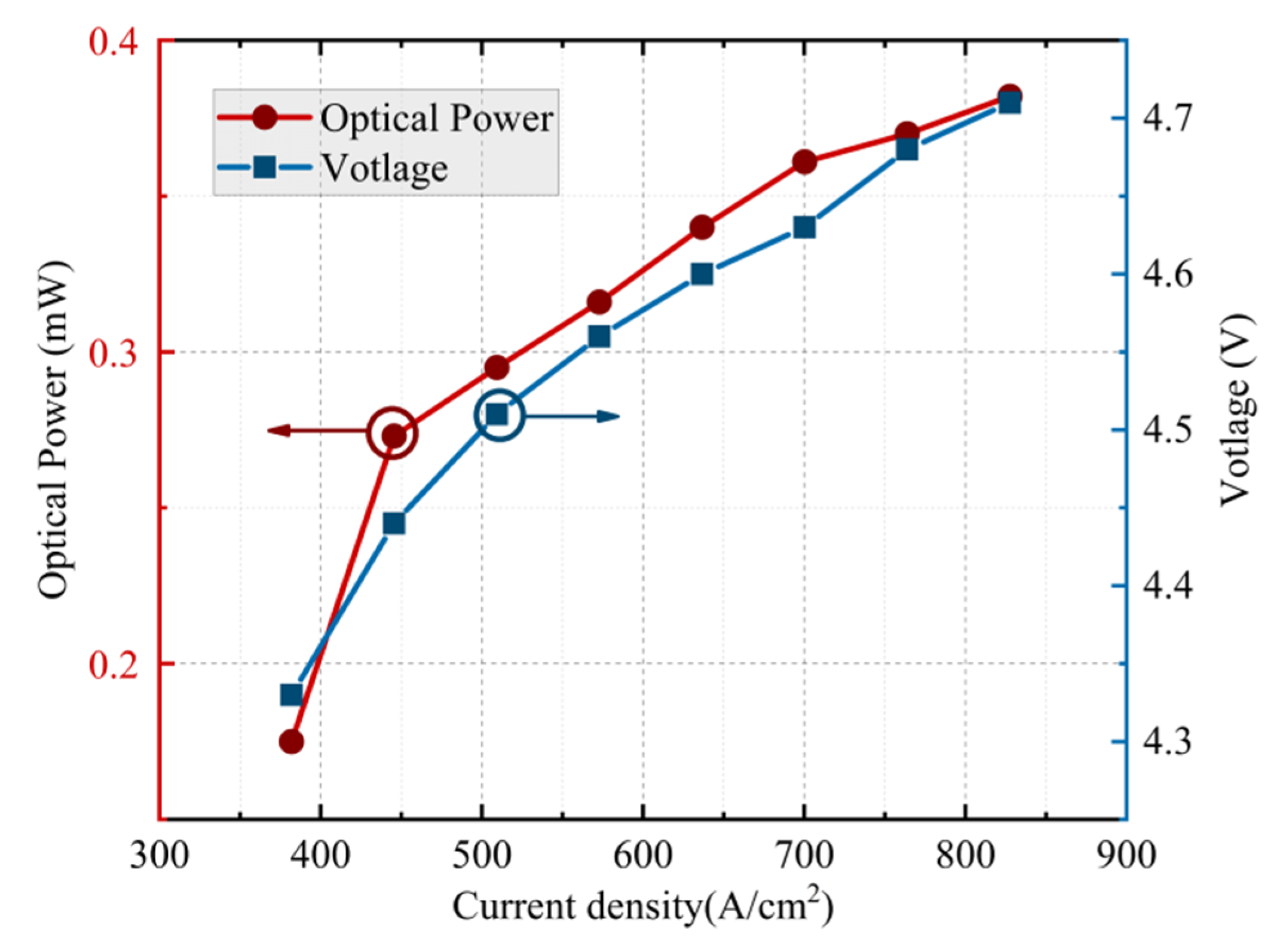
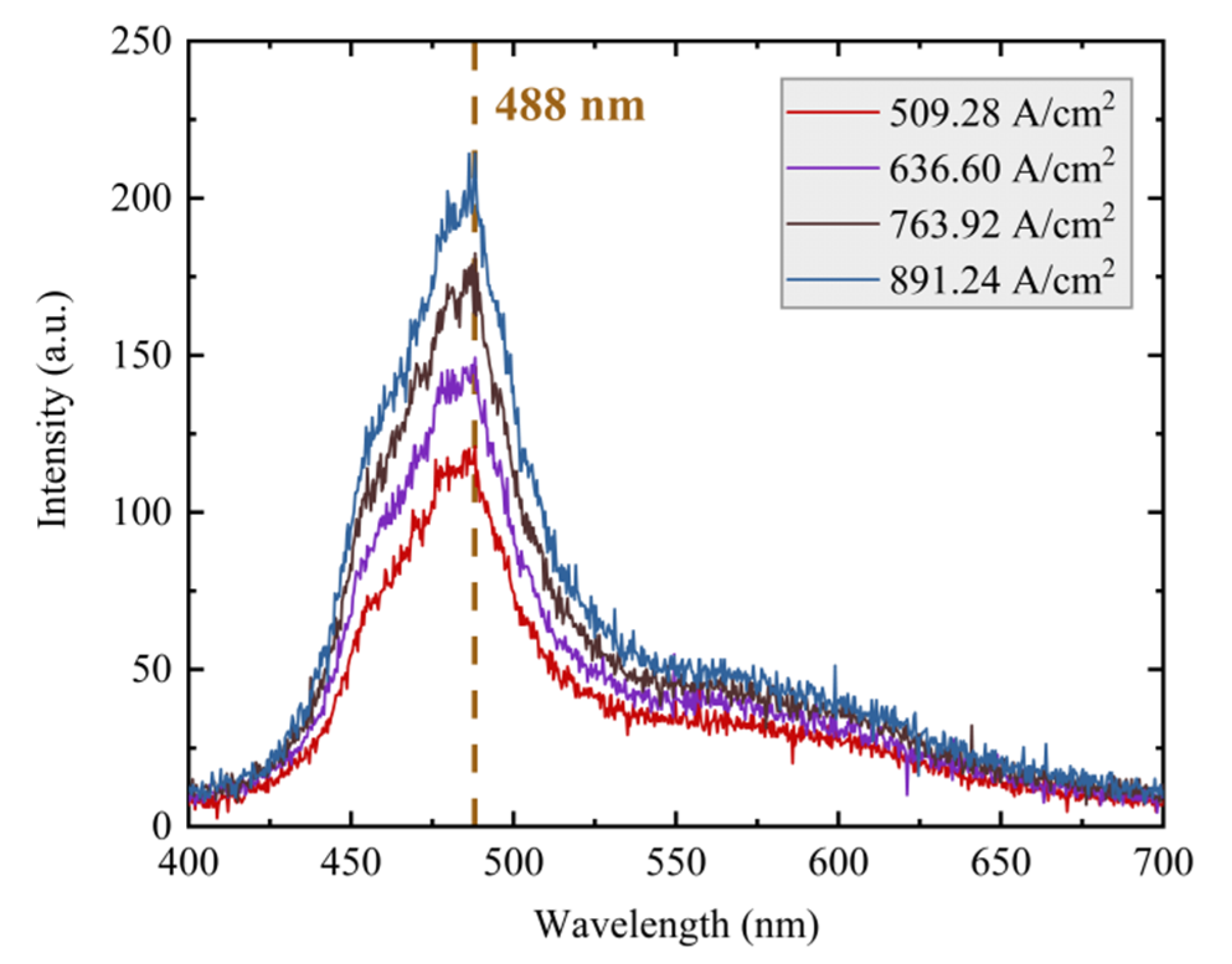
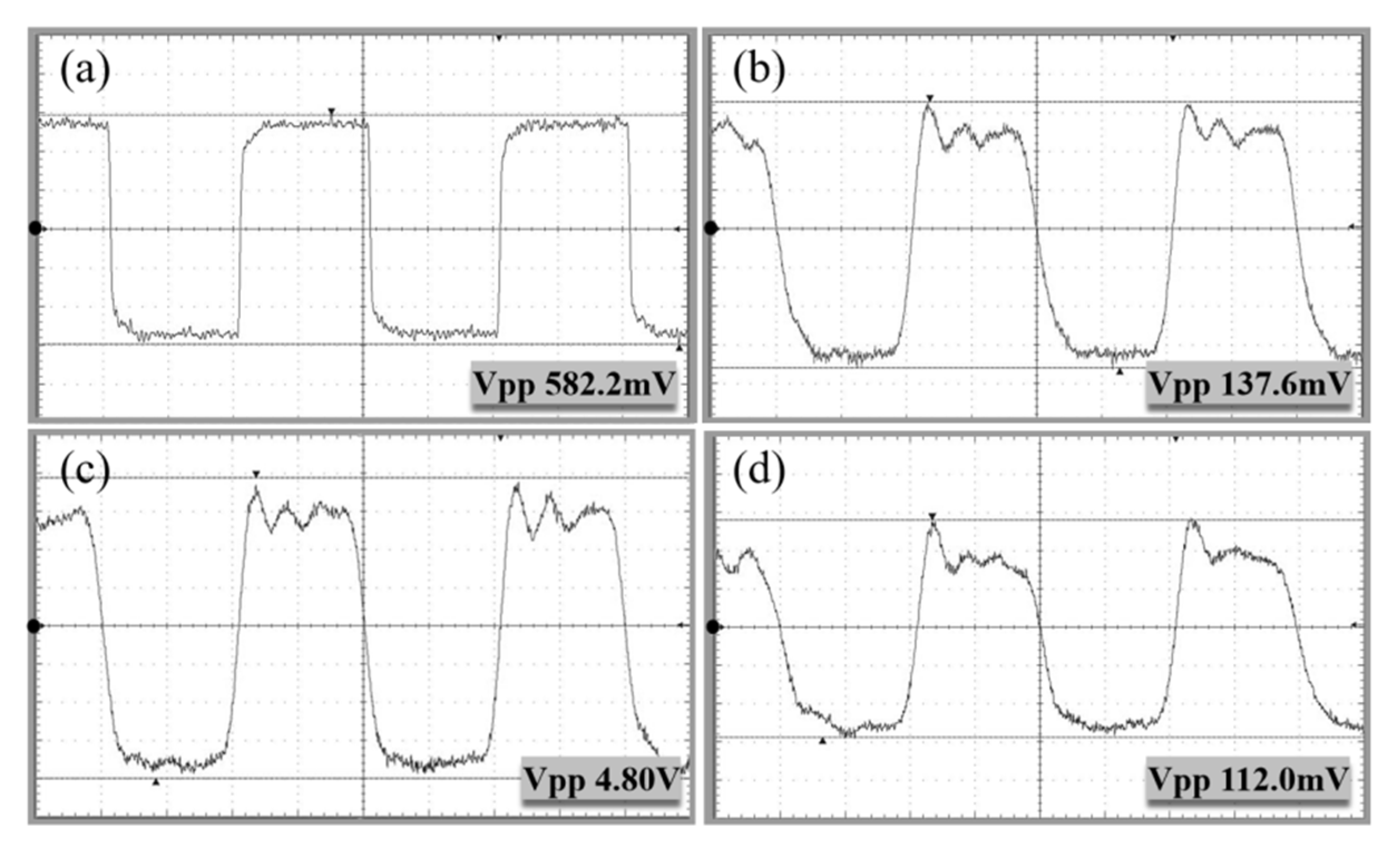
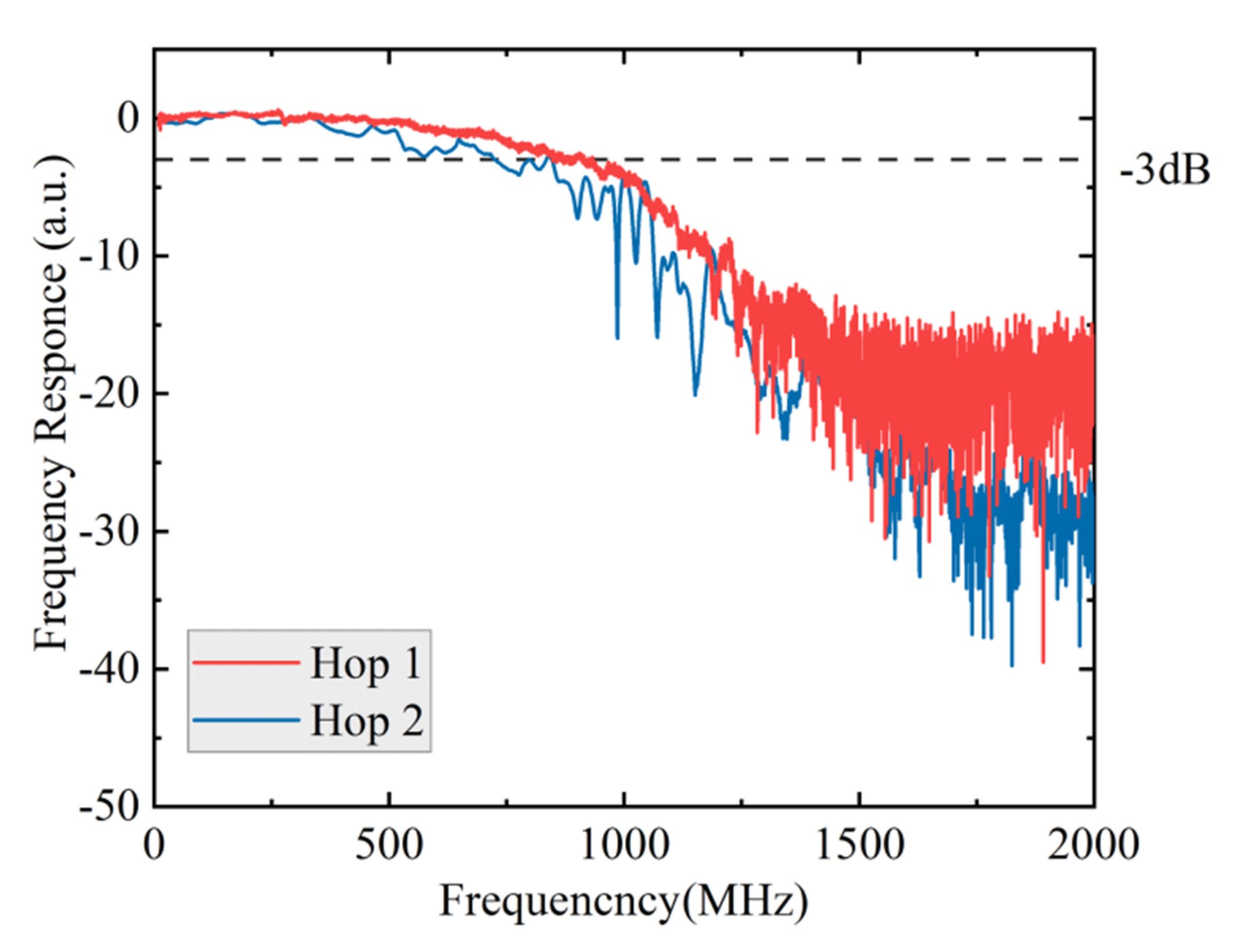
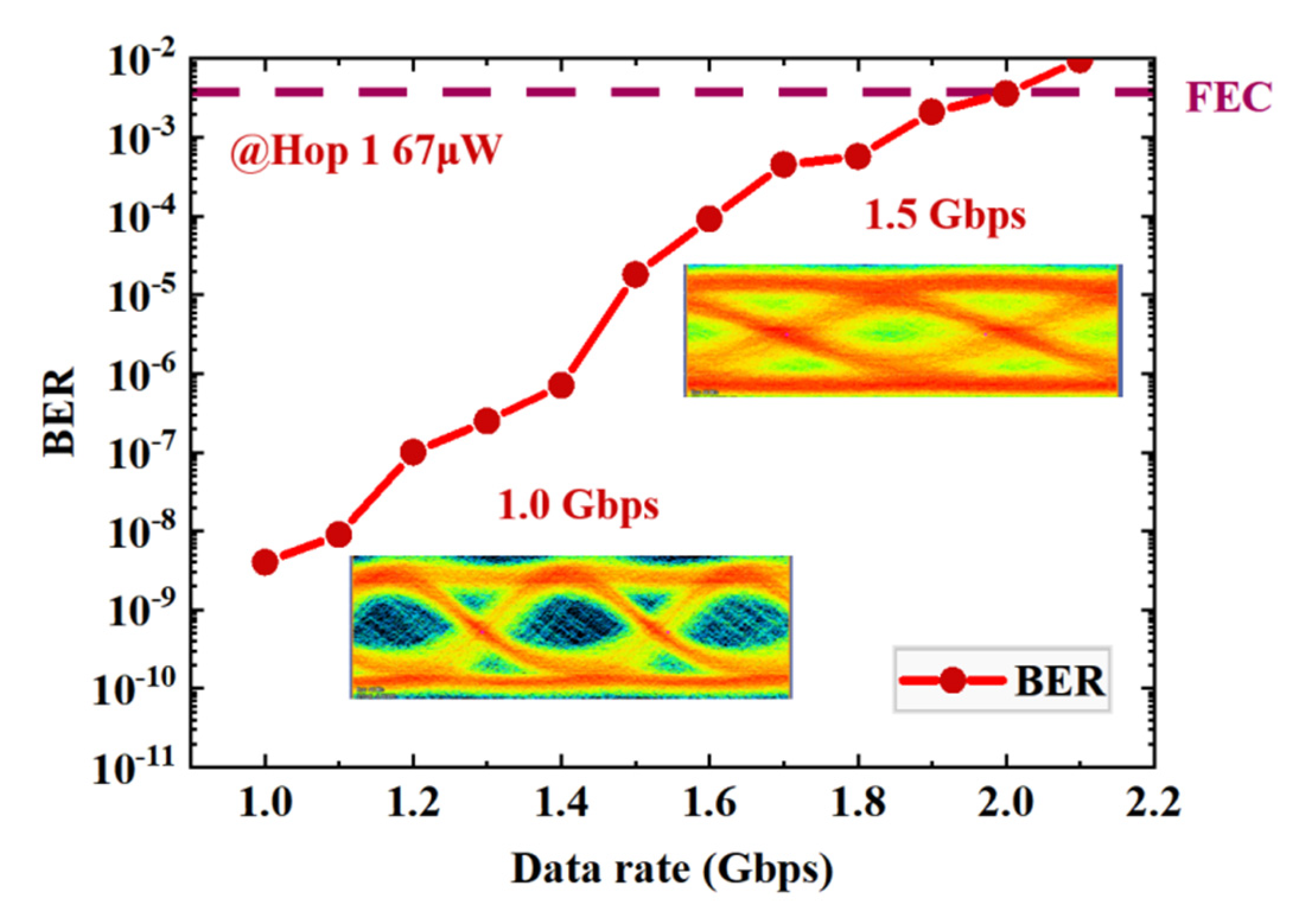



| Parameter | Hop 1 | Hop 2 |
|---|---|---|
| Transmitter | 100 μm micro-LED | 100 μm micro-LED |
| Output optical power | 67 μW | 63 μW |
| Receiver | APD210 (1 GHz) | APD210 (1 GHz) |
| The length of PRBS | 231−1 | 231−1 |
| Modulation format | OOK | OOK |
| Bias voltage | 4.48 V | 4.49 V |
| Modulation depth (Vpp) | 5.3 V | 5.2 V |
| Amplifier | SHF | SHF iXblue |
| Distance | 2 m | 4 m |
| Link | Distance | Vpp | Bandwidth | Data Rate (FEC) |
|---|---|---|---|---|
| Hop 1 | 2.0 m | 137.6 mV | 880 MHz | 2.0 Gbps |
| Hop 2 | 4.0 m | 112.0 mV | 715 MHz | 1.1 Gbps |
Publisher’s Note: MDPI stays neutral with regard to jurisdictional claims in published maps and institutional affiliations. |
© 2022 by the authors. Licensee MDPI, Basel, Switzerland. This article is an open access article distributed under the terms and conditions of the Creative Commons Attribution (CC BY) license (https://creativecommons.org/licenses/by/4.0/).
Share and Cite
Zhang, Y.; Wei, Z.; Wang, Z.; Fu, H.Y. Real-Time Receive-Forward NLOS Visible Light Communication System Based on Multiple Blue Micro-LED Nodes. Photonics 2022, 9, 211. https://doi.org/10.3390/photonics9040211
Zhang Y, Wei Z, Wang Z, Fu HY. Real-Time Receive-Forward NLOS Visible Light Communication System Based on Multiple Blue Micro-LED Nodes. Photonics. 2022; 9(4):211. https://doi.org/10.3390/photonics9040211
Chicago/Turabian StyleZhang, Yuan, Zixian Wei, Zhaoming Wang, and H. Y. Fu. 2022. "Real-Time Receive-Forward NLOS Visible Light Communication System Based on Multiple Blue Micro-LED Nodes" Photonics 9, no. 4: 211. https://doi.org/10.3390/photonics9040211
APA StyleZhang, Y., Wei, Z., Wang, Z., & Fu, H. Y. (2022). Real-Time Receive-Forward NLOS Visible Light Communication System Based on Multiple Blue Micro-LED Nodes. Photonics, 9(4), 211. https://doi.org/10.3390/photonics9040211







